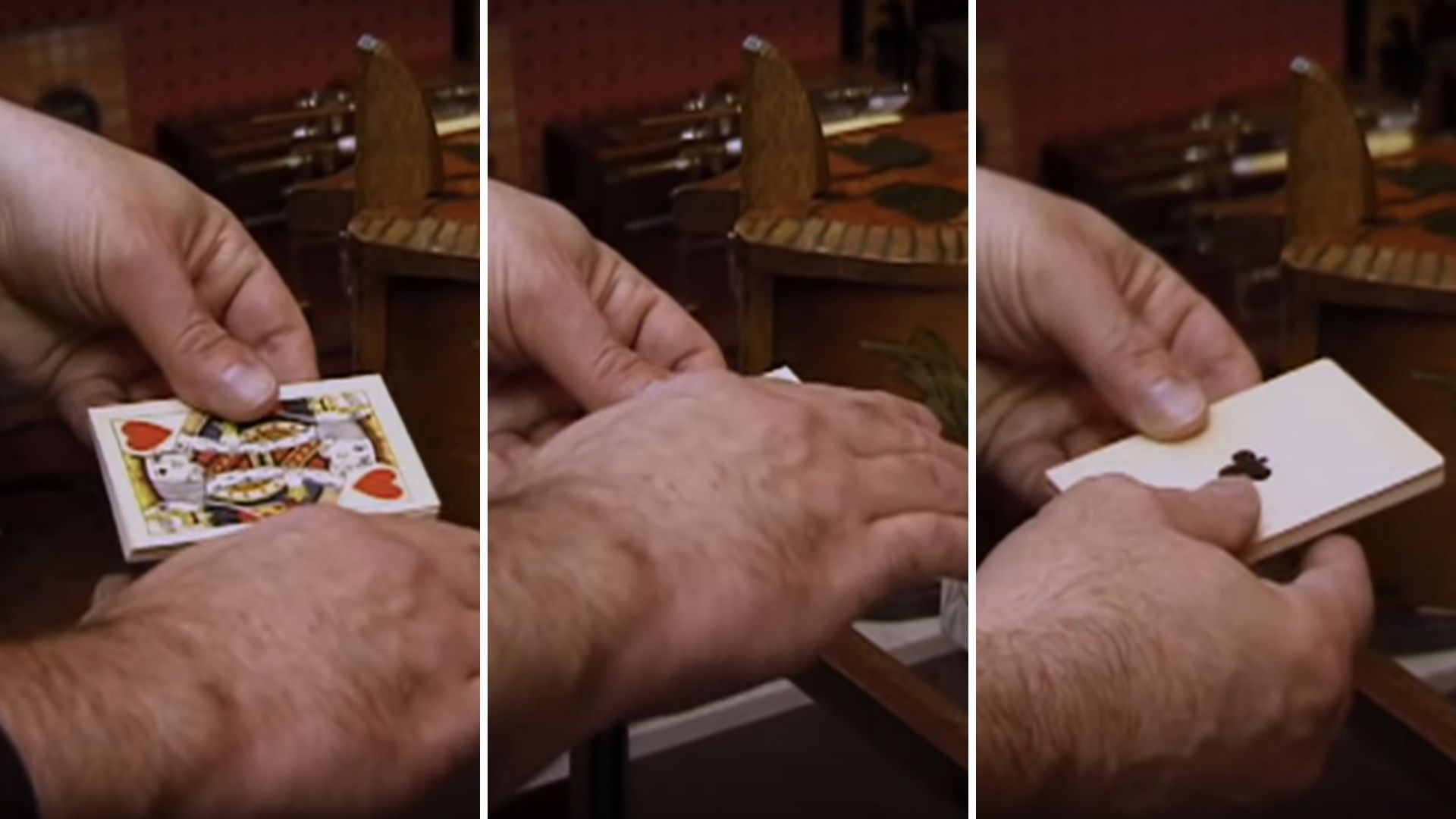Invisible persuasion tricks—
You can read copy over and over and never spot them
Before he died in 2019, Ricky Jay was the world’s best sleight-of-hand artist.
Ricky loved to perform elaborate card tricks for friends in small and intimate settings. But he also didn’t mind recording an entire special, with an audience, and cameras focused on his hands.
You can watch Ricky Jay’s magic special a hundred times (as I’ve done, when I should have been working instead).
But even when the camera zooms in on Ricky’s hands, you’ll still never catch how he does his sleight-of-hand. He’s just too good and too practiced.
 Secret “thriftstore trick” makes the king of hearts disappear. Amazing!
Secret “thriftstore trick” makes the king of hearts disappear. Amazing!
And it’s the same thing in copywriting. As Parris Lampropoulos once said:
A copywriter’s best tricks are “all invisible. You don’t see how he’s manipulating you.”
John Carlton agrees:
“The ads you see in the wild are finished products. All the work that went into creating that finished product is invisible. There’s no ‘infrastructure’ to an ad, no curtain to peek behind once it’s posted or printed.”
Bullets are the essence of effective copy. But if you’re trying to own this skill so you can break into the field, here’s what NOT to do:
Don’t rush out in search of bullets written by A-list copywriters… and then stare at them… hoping to glimpse how the trick is done.
That’s about as likely to make you into an A-list copywriter as watching Ricky Jay is to make you a great sleight-of-hand artist. In other words, zero chance.
In fact, it might even backfire.
You might end up misapplying a formula: “The amazing secret of the one-legged accountant.”
If you write something like this, your copy will make a thud when it falls flat in the middle of your market… and you will look foolish and incompetent to boot.
My point is, you can’t just look at pro copy and understand these inside tricks. You need something extra.
You need a method, like John Carlton says, to “peek behind the curtain.”
And the amazing thing is, such a method exists. As I told you at the start, Gary Halbert revealed it himself, in an old issue of his newsletter.
In Gary’s own words:
“Really the best way for you to get the ‘knack’ of writing bullets is to read bullet-laden ads and then, order the book or product the ad is selling and study it till you are proficient in spotting the ‘source’ of the bullet.”
Gary’s idea is that once you see the source of the bullet, you’ve got the raw ingredients. And when you look at the finished bullet also, then the A-list copywriter’s tricks and tactics soon become obvious.
It’s like having a hidden camera inside Ricky Jay’s bedroom, which shows you the preparation behind his magic trick. You get to peek behind the curtain.
Interesting. Except, does it really work? All I can tell you is…
The pros themselves have followed this exact process.
Ben Settle says that following Gary’s method allowed him to see the “mindset and psychology and ideas behind the bullets.” As a result, Ben says, it became “very easy to learn the craft.”
And Parris Lampropoulos said this is exactly what he did at the start of his career. “I used to get the book, look up the bullet, and see, ‘Ooh, so that’s how they did it!’” Very soon, Parris was writing million-dollar sales letters himself.
Even the great Gary Bencivenga, the “world’s greatest living copywriter” I mentioned on the previous page, followed this very same practice.
Once upon a time, a young Gary Bencivenga had to compete against Gene Schwarz, the legendary copywriter and author of the cult book Breakthrough Advertising. Gary wrote up a first draft to try to beat Gene’s control sales letter. But when Gary compared what he had written to the control, he got depressed — his bullets were so much weaker than Gene’s.
So what did he do? In Gary’s own words:
I said, the only way I’m going to have a way of competing with Gene is if I figure out what he’s done to get these bullets.
So wherever his bullets came from, I would read the same page. I would learn from him just by mimicking what he had done.
So I said, “This bullet that he came up with came from chapter 3, page 4. What is the original source of this?”
And he taught me so much, just by studying his copy and by looking at the product itself.
I was able to beat him, but it was really his package too in a way, because I learned the technique.
That was good enough for me. So I decided to to take Parris’s advice, which meant taking Gary’s advice.
And I did just what they told me to do.
I pulled out an old ad Gary Halbert had written. It was for a book of his called “Killer Orgasms!”
Unfortunately, Gary Halbert is dead. And you can’t buy his sex book anywhere any more.
But on a whim, I took a bullet from that ad and I typed it into Google. And after digging around the Internet, an incredible thing happened. I managed to find Gary’s original book. It was archived online in a public database:
 Gary Halbert’s sex book — not very interesting for the sex, but fascinating for the copywriting instruction.
Gary Halbert’s sex book — not very interesting for the sex, but fascinating for the copywriting instruction.
The cover of “Killer Orgasms!” features a picture of Gary’s topless girlfriend. But who cares about that? I jumped to the content the bullet was selling.
“So that’s it!” I said.
“That’s the little known foreplay secret to making certain your woman will have an explosive orgasm… every time! ”
It turns out Gary’s “secret” wasn’t much of a secret at all. But what was fascinating — and a real secret — was the trick Gary used to turn it into an intriguing bullet.
I call it the “copycat trick.” If you’re interested, you can read more about it below.
This was just one of the A-list secrets I soon discovered. Because, starting with that first peak behind the A-list curtain, I was hooked.
I kept collecting more and more bullety classic sales letters. John Carlton… Gene Schwartz… Gary Bencivenga… Parris Lampropoulos… David Deutsch… Jim Rutz… Arthur Johnson… Eric Betuel.
It wasn’t easy to find all those sales letters, but it wasn’t very hard either.
What was much harder was tracking down the actual books and products they were selling.
A few were still for sale. But many were out of print. It didn’t matter. I was obsessed. I did what I had to.
Because with each new sales letter, and with each new source text, I could go in, and look up new A-list bullets.
And just like Gary said, and Parris said, and Ben Settle said…
… I discovered the mindset and psychology behind the copy of those A-list copywriters.
I found what they zoomed in on. I found what they they chose to leave out. I found how they took a dry and technical fact and made it sexy and exciting. But that’s not all.
Because I also found a bunch of down and dirty tricks and tactics, which I’d never heard about anywhere before.
I’ll give you a few examples in just a moment. But first, this might be a good time to introduce myself.
My name is John Bejakovic. I’m a copywriter. I’ve been at it for the past 8 years.
My clients have included many 7-figure and several 8-figure businesses — among them supplement companies, real estate investment gurus, and direct response ecommerce brands.
But who I am doesn’t matter too much. I’m really just here to pass on this bullet knowledge to you, in case you want it.
All you might care to know about me is that I make a good living writing copy… that I work when I want (usually mornings) and where I want (all around the world)… and that I’ve spent thousands of hours and tens of thousands of dollars sharpening my copywriting chops.
And the only reason you might care about that last part is that it gives some weight when I say the following:
By taking Gary’s advice, I discovered a bunch of A-list copywriting tricks, tactics, and ideas I’d never heard of before. Never, in spite of studying copywriting for years.
And if you think that’s an overstatement, then let me tell you a few of the things I found out:
• How A-list copywriters shamelessly make up facts and figures. Yep, they make up stuff in their copy, and you can do it too. It makes your copy more persuasive… and, as long as you follow what the A-listers do, the FTC won’t come a-knocking.
• The #1 fix for bullet secrets that are too easy to guess. Most B-level copywriters follow their gut on this. As a result, they weaken their copy. So Gary Bencivenga, David Deutsch, and Parris Lampropoulos take the exact opposite path of what comes naturally.
• Gary Halbert’s “copycat trick” for hyping up his readers so much… that they were almost sure to feel disappointed later. As long as you don’t go overboard (like Gary often did) this trick is perfectly ethical — and still immensely powerful.
• “How to use an ordinary hairbrush to quit smoking.” I discovered the secret to this (and many similar) brain-teasers by Parris Lampropoulos. Once you find out the little trick Parris is using… you too can mass-produce intriguing bullets on demand.
• A critically important but often-forgotten bullet element. It’s not promises or proof or even intrigue. It’s also not present in most bullets… or even the source material… but if you omit it when it’s needed, then you’re sure to lose the sale.
• The sneaky 7-word phrase Gary Bencivenga used to get away with making extreme promises. Gary Bencivenga was famous for providing proof in his copy… but this has nothing to do with proof. It’s pure A-list sleight-of-hand.
Are you intrigued? If you are, then let me give you two options:
Option A: Find out the secrets behind these particular bullets, or…
Option B: Discover how you yourself can own bullets more quickly than you would ever believe, and set yourself apart from the masses of other marketers and copywriters.
So which one do you want? A or B?
But let me come clean. I won’t really make you choose. Just click through to the next page, where I’ll tell you about the easiest and fastest way to do both.